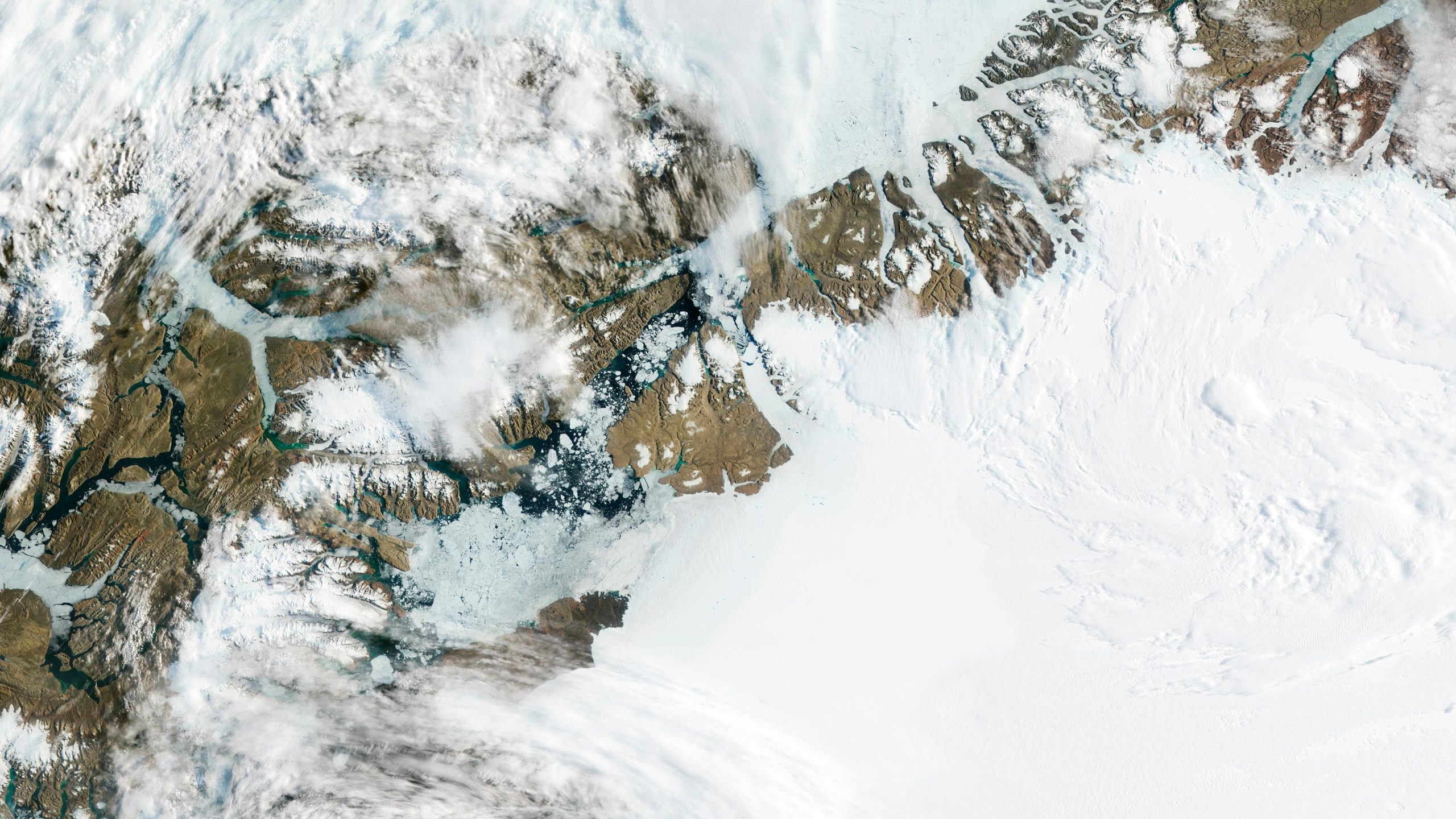En el centro de esta fotografía de la NASA tomada en 2012, el glaciar Petermann en el noroeste de Groenlandia se desplaza gradualmente hacia el océano, con grandes segmentos que se desprenden y retroceden como icebergs. Investigadores de UCI y JPL de la NASA utilizaron datos satelitales de tres misiones europeas para descubrir cómo el agua cálida del océano está causando que la línea terrestre del glaciar migre, lo que lleva a su rápido deterioro. Crédito: NASA
El estudio sugiere que la magnitud del futuro aumento del nivel del mar puede estar muy subestimada.
Una nueva investigación ha encontrado que la línea base del glaciar Petermann en Groenlandia se desplaza durante los ciclos de las mareas, lo que permite que el agua de mar caliente acelere el derretimiento del hielo. Esta interacción previamente desconocida podría causar un aumento del 200% en las proyecciones de aumento del nivel del mar para los glaciares que terminan en el océano si se incluye en los modelos.
Mientras realizaban un estudio del glaciar Petermann en el noroeste de Groenlandia, los investigadores de la Universidad de California, Irvine y el Laboratorio de Propulsión a Chorro de la NASA descubrieron una forma nunca antes vista en la que interactúan el hielo y el océano. Los glaciólogos dijeron que sus hallazgos podrían significar que la comunidad climática ha subestimado enormemente el alcance del futuro aumento del nivel del mar causado por el deterioro del hielo polar.
Utilizando datos de radar satelital de tres misiones europeas, la UCI/[{» attribute=»»>NASA team learned that Petermann Glacier’s grounding line – where ice detaches from the land bed and begins floating in the ocean – shifts substantially during tidal cycles, allowing warm seawater to intrude and melt ice at an accelerated rate. The group’s results are the subject of a paper published on May 8 in Proceedings of the National Academy of Sciences.
“Petermann’s grounding line could be more accurately described as a grounding zone, because it migrates between 2 and 6 kilometers as tides come in and out,” said lead author Enrico Ciraci, UCI assistant specialist in Earth system science and NASA postdoctoral fellow. “This is an order of magnitude larger than expected for grounding lines on a rigid bed.”
He said the traditional view of grounding lines beneath ocean-reaching glaciers was that they did not migrate during tidal cycles, nor did they experience ice melt. But the new study replaces that thinking with knowledge that warm ocean water intrudes beneath the ice through preexisting subglacial channels, with the highest melt rates occurring at the grounding zone.
The researchers found that as Petermann Glacier’s grounding line retreated nearly 4 kilometers – 2½ miles – between 2016 and 2022, warm water carved a 670-foot-tall cavity in the underside of the glacier, and that abscess remained there for all of 2022.
“These ice-ocean interactions make the glaciers more sensitive to ocean warming,” said senior co-author Eric Rignot, UCI professor of Earth system science and NASA JPL research scientist. “These dynamics are not included in models, and if we were to include them, it would increase projections of sea level rise by up to 200 percent – not just for Petermann but for all glaciers ending in the ocean, which is most of northern Greenland and all of Antarctica.”
The Greenland ice sheet has lost billions of tons of ice to the ocean in the past few decades, the PNAS paper stresses, with most of the loss caused by warming of subsurface ocean waters, a product of Earth’s changing climate. Exposure to ocean water melts the ice vigorously at the glacier front and erodes resistance to the movement of glaciers over the ground, causing the ice to slide more quickly to the sea, according to Rignot.
Reference: “Melt rates in the kilometer-size grounding zone of Petermann Glacier, Greenland, before and during a retreat” by Enrico Ciracì, Eric Rignot, Bernd Scheuchl, Valentyn Tolpekin, Michael Wollersheim, Lu An, Pietro Milillo, Jose-Luis Bueso-Bello, Paola Rizzoli and Luigi Dini, 8 May 2023, Proceedings of the National Academy of Sciences.
DOI: 10.1073/pnas.2220924120
Ciraci’s research was supported by the NASA Postdoctoral Program at the Jet Propulsion Laboratory. Joining Ciraci and Rignot on the project were Bernd Scheuchl, UCI associate project scientist; Valentyn Tolpekin and Michael Wollersheim of Finland’s Iceye mission; Lu An of China’s Tongji University; Pietro Milillo of the University of Houston; Jose-Luis Bueso-Bello of the German Aerospace Center; and Luigi Dini of the Italian Space Agency.

«Maven de internet exasperantemente humilde. Comunicadora. Fanático dedicado al tocino.»
También te puede interesar
-
En medio de la incertidumbre del programa, Boeing despedirá a los trabajadores del programa de misiles SLS
-
Enorme reptil marino antiguo identificado por hallazgo de fósiles de un aficionado
-
SpaceX lanza el cohete Falcon 9 en la misión Starlink desde el Centro Espacial Kennedy – Spaceflight Now
-
¿Podrás sobrevivir sólo con jugo de naranja? El experimento de 40 días de una mujer
-
El equipo de helicópteros Ingenuity Mars de la NASA se despide… por ahora

